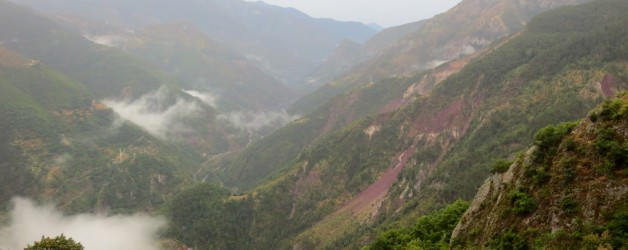I recently took a break from the world of blueprints and budgets in order to me ressourcer, as the French say. It had been a number of years since our last alpine hiking trip, so we decided to head to the French and Italian maritime alps for a bit of beautiful scenery, wonderful food and wine, and days spent earning our meals on the trails which abound in this area.
Our first stop was the French medieval village of Roure, perched at 1100 meters atop a mountain of shockingly red schist (shale)…
Where we made new friends, like the boulanger Eugène di Césare, here. Eugène mans every weekend the enormous wood-fired communal oven (built in 1710). He builds a larch-wood fire inside the oven around 5 pm Saturday, then starts baking breads, pastries, and pizzas early Sunday morning. I can assure you, there are none better!
And Donkey, here. Donkey (pronounced just like Shrek’s Donkey) apparently spends her days wandering the mountains around Roure. We gave her a couple of prunes and became fast friends.
Sunday morning mass was the occasion of this joyous baptism in the beautiful 14th century Église St-Michel-Archange down in the valley below Roure in St-Sauveur-sur-Tinée.
Snow from the evening previous to our departing Roure and a steady morning rain welcomed us across the Col de la Lombarde (Colle della Lombarda) out of France and into the provincia di Cuneo, Italia. Euh…io non parlo italiano.. Parla inglese ? francese ?
Happily, the sun did finally shine, and we enjoyed a few very pleasant days at the Albergo della Pace in the tiny village (population 89) of Sambuco (elevation 1200 meters) in the Stura valley. That’s Monte Bersaio in the background. We hiked to the top (2384 meters) only to be enshrouded in clouds and then rain…a spoiled pique-nique!
A nice view of Monte Bersaio from the opposite slope. Note the breach in the barrier wall…watch out for falling rocks!
A few more friends made along the way.
Don’t forget to stop and smell the roses…euh, crocuses.
Another day, another hike. This time over the Col de Larche (Colle della Maddalena) back into France and the magnificent alpine scenery of the Haute Ubaye.
Thank goodness for the sign posts!
Time to leave Sambuco and our second travel day brings us back through France where we stop to nous restaurer. Pizza au feu de bois and tagliatelles aux cèpes in the animated, medieval town of Tende in the Haute Roya valley.
A postprandial stroll around town before getting back on the road provides this glimpse of Tende’s beautiful former cathedral, Notre Dame de l’Assomption, built in the 15th century’s Renaissance style.
I would be remiss if I failed to snap a few shots of a purely builderly nature…
And, on to our final destination, Pigna, and her hilltop sister, Castelvittorio, in the Ligurian hinterlands…
Where one does not want to harvest the porcini (cèpes) without a permit.
The forested mountains are thick with these…
And with these. One you eat, and one you don’t. Do you know which is which?
Liguria’s hillsides are dotted with orotori like this one dedicated to Santa Maria…
And with small chapels often accessible only on foot.
Midway between the villages of Pigna and Castelvittorio, on a steep mule track, you’ll find this magnificent, deconsecrated church from the 11th century…
Which is more than a little creepy inside.
From high in the hills above Castelvittorio we could hear the oom-pah notes of this banda musicale and were drawn into the Piazza XX settembre to investigate the source of the rejoicing that had carried so far. We discovered that this delightful Dutch couple had chosen this enchanting setting to celebrate their nuptial vows.
I couldn’t not tell you about the best meal of this battery-recharging trip. Just off the Piazza XX settembre is Mara’s Osteria della Portico. Mara serves lumache (pictured above) as well as coniglio alla Ligure (rabbit with green olives), cinghiali (wild boar), ravioli con patate, pasta sciacaa, all washed down with the excellent local Rossese di Dolceacqua. Magnifico!
Finally, I leave you with a scene (Gesù incoronato di spine) from Pigna’s Chiesa San Bernardo. This magnificent church’s entire walls and ceilings were painted in fresco in 1482 by Giovanni Canavesio.


























